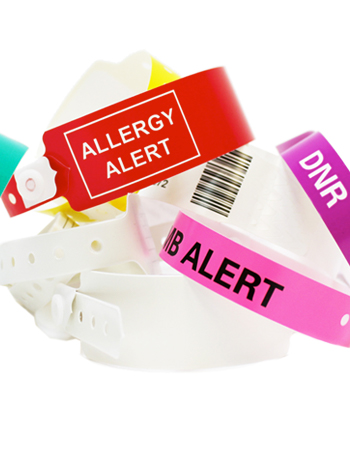Enhancing Security: The Importance of Person Identification Bands in Healthcare
In the realm of healthcare, the efficacy of client recognition bands can not be overemphasized, as they serve as a basic secure against misidentification and succeeding errors. As we explore the complex duty of these bands, it ends up being noticeable that their relevance expands beyond mere identification, elevating concerns about finest practices and future advancements in client security.
Summary of Individual Recognition Bands
Patient identification bands play a critical duty in making certain the security and accuracy of patient care in healthcare setups. These bands, generally worn on the wrist or ankle joint, act as an essential tool for verifying client identification, thus lessening the threat of mistakes in therapy, medication management, and various other health care procedures. Made from durable materials, client identification bands frequently consist of essential info such as the individual's name, date of birth, medical document number, and barcodes or QR codes for scanning.
The execution of person identification bands is crucial in different health care atmospheres, consisting of health centers, outpatient facilities, and lasting care institutions. They add to a systematic approach in patient management, allowing health care experts to rapidly and precisely recognize clients, especially in high-pressure scenarios where speedy decision-making is important.
Furthermore, using these bands is lined up with regulatory standards intended at improving individual security - Patient Identification Band. By guaranteeing that each patient's information is easily verifiable and easily available, health care service providers can maintain a high standard of treatment, decrease the occurrence of negative occasions, and promote a culture of safety and security within healthcare organizations
Benefits of Accurate Recognition
Exact recognition is fundamental to improving person safety and security and care top quality in medical care settings. It offers as the very first line of defense against mistakes that might bring about unfavorable person results. By making sure that each person is correctly recognized with dependable methods, such as individual identification bands, doctor can considerably reduce the risk of misidentification, which can lead to unacceptable therapies, drug errors, and even medical mix-ups.
Furthermore, exact person identification helps with efficient interaction among medical care groups. When all employee can regularly recognize people, they can share crucial information a lot more efficiently, resulting in far better sychronisation of care. This is especially vital in emergency situation scenarios where prompt treatments are vital.
Additionally, accurate recognition supports compliance with regulatory criteria, consequently reducing the threat of lawful effects for healthcare centers. It promotes count on in between people and doctor, as people really feel extra protected recognizing that their identities are being secured.

Typical Difficulties Encountered
Ensuring effective client recognition in medical care settings offers a series of difficulties that can jeopardize safety and security and care quality. One significant difficulty is the irregularity in patient populations. Individuals may get here in a state of complication or distress, making exact identification hard. Furthermore, language obstacles can prevent efficient interaction, complicating the confirmation procedure.
One more challenge is the dependence on human factors in identification procedures. Health care professionals might inadvertently misunderstand or overlook identification procedures, especially in high-stress settings such as emergency situation departments. This can bring about mistakes, including the administration of incorrect therapies or drugs.
Technological problems also posture difficulties. Electronic health record (EHR) systems are designed to improve individual recognition, system failures reference or customer mistakes can disrupt the process. Furthermore, the physical layout of person ID bands can lead to readability issues, especially in situations where bands are harmed or obscured.
Finally, inconsistent training amongst team relating to recognition protocols can result in gaps in understanding and method. Dealing with these obstacles is vital for improving individual safety and making certain that recognition bands offer their desired purpose efficiently.
Finest Practices for Implementation
To efficiently carry out individual recognition bands in healthcare settings, organizations must embrace a complex approach that prioritizes training, standardization, and modern technology assimilation. Standardization includes establishing clear procedures for the design, application, and use recognition bands throughout all departments. This guarantees uniformity and reduces the threat of errors connected to differences in band kinds or identifying approaches.


Training is necessary for all medical care personnel to ensure they recognize the significance of accurate client recognition, how to correctly use and read identification bands, and the procedures to follow in instance of inconsistencies. Routine workshops and refresher course programs can reinforce this knowledge and advertise a culture of security.
Modern technology combination plays a crucial function in enhancing the performance find out of client recognition bands. Utilizing barcode scanning or RFID innovation can simplify the identification procedure, enabling real-time verification of individual identifications. Furthermore, digital wellness record systems must be set up to include notifies for inequalities in between the identification band and individual information.
Future Trends in Individual Safety And Security
As health care remains to evolve, the emphasis on individual safety and security is most likely to magnify, driven by innovations in technology and a higher understanding of systemic dangers. Arising trends suggest a change in the direction of even more integrated systems that leverage data analytics, expert system, and artificial intelligence to boost person Resources recognition processes. These technologies can help identify prospective security problems prior to they rise, therefore reducing errors related to misidentification.
Moreover, the implementation of blockchain technology may transform how patient data is securely shared among medical care providers, making sure that recognition bands are consistently accurate and updated. This will not only enhance person safety and security but additionally promote smooth interaction throughout multidisciplinary groups.

Additionally, the growing emphasis on tailored medicine is anticipated to affect individual safety and security procedures. By integrating hereditary and group information into identification systems, healthcare experts can tailor treatments much more successfully, decreasing the threats of damaging responses as a result of misidentification.
Verdict
In final thought, client identification bands serve as an important component in boosting security within healthcare settings. Ultimately, the ongoing emphasis on durable identification protocols will certainly add to enhanced individual outcomes and total security in medical care settings.
In the world of health care, the efficiency of individual recognition bands can not be overstated, as they serve as a fundamental secure against misidentification and succeeding errors.Person recognition bands play a critical role in ensuring the security and precision of client treatment in healthcare setups. Made from durable materials, person identification bands usually include necessary information such as the client's name, day of birth, medical record number, and barcodes or QR codes for scanning.
By making sure that each patient is properly identified via dependable ways, such as person identification bands, health care carriers can considerably lessen the threat of misidentification, which can lead to unsuitable therapies, drug mistakes, and even surgical mix-ups.
In final thought, individual recognition bands offer as a vital element in boosting safety within healthcare environments. Patient Identification Band.